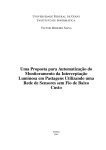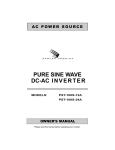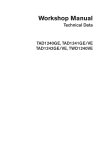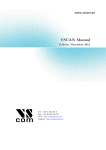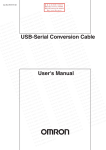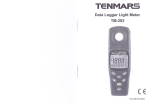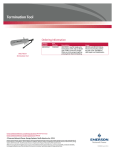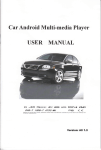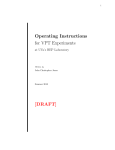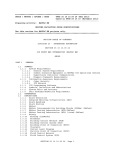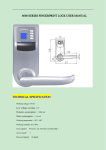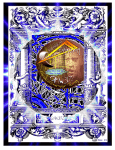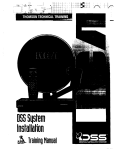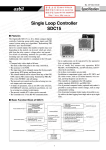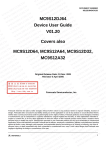Download Digital Radiation Monitor
Transcript
O O W. WW .100Y.C M.TW WW .100Y.C M.TW WW .100Y.C M.TW O WW 00Y.CO .TW W WW 00Y.CO .TW C . W W W Y W W M .1 .T 00 the Radiation W.1 Y.COMUsing .CO .TW WWMonitor W.1 Y.COM W Y W W 0 W W 0 W .T is the general procedure 00 W Here when M using the Digital Radiation Monitor: O W.1to follow M.T .100 Digital Radiation Monitor W.1 Y.COM W C . O W W Y W C . 0 W 1. .Connect the Digital Radiation interface. .TW W T WW .100Y .10 MonitorOtoMthe .TW 100 M . W M O W C . O W W C 2. Start the data-collection software. (Order Code DRM-BTD) . Y W C . 0 W .TW W .TW 10Digital 00Y 3. M WW .100Y M . .TW 1 . O W M The software will identify the Radiation Monitor and load a default dataThe Digital Radiation Monitor is used to monitor alpha, beta, W Y.C WW 00Y.CO collection W setup1. You .CO .TW 0 WW T WW . 0 Y W T . are now ready to collect data. and gamma radiation. It can be usedW with a number of 1 0 M . 1 0 M . O 1 W M . O W C O W per specified interfaces to measure the total number ofW counts Y. with the WW is compatible Radiation Monitor following data-collection .TW WW .100Y.CThe Digital .TW 100 0Y.C W it can M . .TW 0also M timing interval. Since it has its own display, be used O 1 W M . O interfaces: W C . O W W C W Y W .C W W radiation independent of interfaces in the field toW measure W WW .100Y.• Vernier M.T .100 00Y M.T LabPro® O W M.T O W C levels. The Radiation Monitor allows students W to .1 . O ® W WW .100Y .TW WW .100Y•.C Vernier .TLabQuest WW .100Y.C M.TW M • Detect the presence of a source of radiation. M O W O W .C ® Mini W O W LabQuest W W .TW W type of WW .100•Y.CVernier 00Y Y.C T • Monitor counts/interval (rate) as different of a particular . 1 0 WW thicknesses T M . . 0 M ™ O 1 W CBL 2 W W • Texas .C OM shielding are placed between the Geiger-Mueller Radiation Monitor W. tube of the CO Instruments W W 00Y WW .10•0Y.Vernier ® .TW 1 WW .100Y.C M.TW M.T SensorDAQ . and a beta or gamma source. M O W O W C O .C WW .100Y. WW to0shield .TW • Compare the effect of different types ofW materials or .gamma WW .Specifications .TW 00Y 0Y.CbetaM TW M 1 M O 1 W . W radiation. O W W .CO 712 .(or WW .100Y.CGM tube W 0YLND Y.C how initial WW Sensor: TW equivalent) halogen-quenched 0 0 WW T M.Twith a mica end . 1 0 M . • Set up a histogram with a very long run time to show students O 1 W M . 2 O W C O counts 1.5 .C to 2.0 .mg/cm Y. per minute WWat 1000 WW 00curve. .TWusing a Cesiumrandomness of data develops into a Gaussian Y.C WW window, TW thick. Rated 100 00Y Wdistribution M . .TW 1 M . 137 laboratory standard. O 1 W M . O W .C O mantels or Wsuch as lantern • Measure radiation of common radioactive materials, W WW a battery 00Ylife of 2000 0Y.C WWPower: 9-voltM alkaline .TW battery provides 1 0One WW .100Y.C M.TW M.Thours at normal . 1 . old Fiestaware. O W O W C . W backgroundYradiation levels. .C .CO .TW WW .100Y .TW WW • Monitor variation in background radiation at different .TW 00±10% typical, WW elevations. M 1 00Y M . O 1 Accuracy: ±15% max. (mR/hr and µSv/hr modes) W M . O .C O W of time. WW 00Y.C • Monitor radioactivity in the environment over longW periods WW .TW W 00Y Y.C WDimensions: TW 1 0 150 x 80M x .30 mm (5.9" x 3.2" x 1.2") W T M . . 1 0 . O 1 W . O • Monitor counts per interval (rate) from a beta or gammaWradiation source .C OMas a W W WW 22500gY Weight: (8.C oz) with.battery W W 00Y Y.C W TW installedW 1 0 function of the distance between the source and the Monitor. WRadiation T M.T . . 1 0 M . O 1 W M . O W Energy Sensitivity: referenced W Y.C .CO .TW Y.C1000 CPM/mR/hr WW to Cs-137 .TW WW .100Chirps .TW 100mode only–can WWthat allows M . The Digital Radiation Monitor includes a cable (RCD-BTD) 00Ythe monitor M Audio Output: for each count (operational in audio be muted) O 1 W M . O O W W W .C–20°C Y.C WW Range: C to be connected to a data-collection interface. W . 0 Y W T W . W 0 0 Y W T Temperature to 50°C . W M .1 .T .10 100 3.5 mm OM W The cable that accompanies the DRM-BTD Radiation Monitor hasW a.small OM WW 00Y.CO C . W Operating Range: C W . Y W W W 0 Y W 0 0 W digital (micro-miniature) stereo jack on one end and a white rectangular .1 .T 0British M.T mR/hr: toO110 W.1 0.001 WW W.1 theY.COM W C . W Telecom (BT) plug on the other end. This cable is used to directly connect W Y W W W CPM: .100 0to 350,000M.T W®, or SensorDAQ DRM-BTD to the Vernier LabQuest®, LabQuest® Mini, LabPro .100 ®, OM.T O W WW 1 0to09,999,000 TM C Y.C W WTotal: or to the Texas Instruments CBL 2 . .TW WW .100Y. T . 1 Mcounts . M O W O W C µSv/hr: . W 0.0100toY1100 W WW .100Y.C M.TW 1to 3,500 . CPS: 1 W O W Extended User Manual WW WW .100Y.C M.TW O W A more extensive user manual can be viewed from the Digital Radiation Monitor WW .100Y.C M.TWHow the Radiation Monitor Works page of the Vernier web site, www.vernier.com/probes/drm-btd.html. O W The Radiation Monitor senses ionizing radiation by means of a Geiger-Mueller WW .100Y.C (GM) tube. The tube is fully enclosed inside the instrument. When ionizing radiation W W NOTE: This product is to be used for educational purposes only. It is not appropriate or a particle strikes the tube, it is sensed electronically and monitored by its own W for industrial, medical, research, or commercial applications. display, a computer, or by a flashing count light. When the switch is in the AUDIO position, the instrument will also beep with each ionizing event. It is calibrated for 1 If you are using a LabPro or CBL 2 for data collection, the sensor will not auto-ID. Open an experiment file in Logger Pro or manually set up the sensor. 2 O O W. WW .100Y.C M.TW WW .100Y.C M.TW WW .100Y.C M.TW O O of relative intensities W WW 00Y.CO .TW W C Cesium-137, but also serves as an excellent indicator forW other 0Y.C W . W W W Y W T . 0 .1 .T the Radiation Your Classes OM sources of ionizing radiation.W GammaW radiation per .100 is measured W.1 Y.COMUsing .Cin OM in milli-Roentgens WWMonitor W Y W C W . 0 W W .TMonitor W 0 0 Y W T hour. Alpha and beta are measured (CPM). About 5 to 25 counts at Here are some examples of how the Radiation can be used in a science . 1 0 0 W in counts/minute T M . . 1 0 M . O 1 W M . O class. W C . O W W random intervals (depending on location and altitude) can be expected every minute C W . Y W C W . 0 Y W T . W 0 Y W WWradiation. from naturally occurring background M.T .100 OM W.1Studies vs. Distance M.T .100 OCounts/Interval W C . O W W C . Y W C . mica window 0 collected W below W window. .TbyWmonitoring gamma radiation at The end of the GM tube has a thinW mica This W by .100Y The .TWin the two graphs 10were data M . .TW is protected 00Y M O 1 W M . O W O to reach the GM tube and the screen at the end of the sensor. It allows particles W W collected with the run fromW a Radiation were W 0Y.C Data WWalpha W and gamma 0Monitor. Y.C beta.particles WW .100Y.C various Tdistances . 1 0 T M.Tinterval, the source was moved . be detected. The mica window will W also sense.low energy 0 M O 1 intervals set at 100 seconds. After each 100 second W M O W C W or the Y Y. distance .CO radiation that cannot penetrate the plastic side of the tube. WW .TW WW .100Y.Cone centimeter the source. is proportional to time .TW further from 100 Since O WWcasethrough M . .TWNote: Some M W M .100 the mica very low energy radiation cannot be detectedW window. O W C . O (300 seconds in the first graph corresponds to 3 cm in the W C Wsecond graph; 400 seconds . W .Ttime 00Ymade using WW .100Yto .TWa new distance 1 WW .100Y.C M.TW M . 4 cm, etc.), column was divided by 100. The M O W .C to the .–2 O Further Tips for Monitoring Radiation Wdistance W W .CO fit shown Y WW 00Y C W . curved corresponds to raised power (inverse squared). 0 W T W W 0 Y W T 0 M. .1 To measure gamma and X-rays, hold theW back ofW the Monitor W.1 Y.COM W M.T toward the .10Radiation O W O W C . .C cannot Y W W source of radiation. Low-energy gamma radiation KeV) the WW .TW WW (10–40 M.T .100 .Tpenetrate 100 00Y M . O 1 W M . O W C . O side of the GM tube, but may be detected through the end window. W W W Y .C W WW .100Y.C M.TW WW TW M.T .100 .of 00Y source To detect alpha radiation, position the monitor so the suspected radiation is O 1 W M . O W C O W WW .100Y. .TW next to the GM window. Alpha radiation willW notW travel far00through W the Y.C air, so WW .100Y.C M.TW M .Tput O 1 W M . O W source as close as possible (within 1/4 inch) to the screen without it. Even a O .Ctouching WW .100Y.C M.TW WWparticle W Ycan WW .100Y.C M.TW 0 Walpha T . humid day can limit the already short distance an travel. 0 O W O W OM W.1 Yof .Cradiation. WW .100Y.C M.TW To detect beta radiation, point the end window toward Beta W WW .100Y.C M.TW 0 WW the source T . 0 radiation has a longer range through air than alpha particles, usually OM be WW 00Y.CO .TW W.1but can WW 00Y.CO .TW C . W W W Y W 0 W T shielded (e.g., by a few millimeters of aluminum). High energy .1 W.1 Y.COM W M.may be .10beta particles OM W O W W C . W C monitored through the back of the case. W Y W .T W 00 W WW .100Y. M.T .100 W.1 Y.COM W M.T O W To determine whether radiation is alpha, beta, or gamma, hold the backC ofOthe W W C . . W WW .100Y .TW monitor toward the specimen. If there is an indicationW ofW radioactivity, M.T .100 .TW 00Yit is most M O 1 W M . O W C Counts/interval vs. time and distance . O W W likely gamma or high energy beta. Place a piece of aluminum about 3 mm (1/8") WW .100Y WW .100Y.C M.TW 0Y.C isM WW M.T .TW 0radiation O 1 thick between the case and the specimen. If the indication stops, the most W . O W .C O W W .C Shielding likely beta. (To some degree, most common radioactive isotopes WW .100Yvs. Counts/Interval .TWStudies W W.100Y OM.TW 0Y.Cbeta and WW emit .TW 0both M 1 M . O W O the gamma radiation.) If there is no indication through the back ofWthe Wcase, position The data Y.Cwere .TW WW .100Y.C M.TW 0here Y.Cit is .TW WW shown 0 0 W is an indication, 1 end window close to, but not touching, the specimen. If there 0 collected by monitoring gamma M . O W M O W W.1 and Wwith W .C probably alpha or beta. If a sheet of paper is placed betweenW theW window, theO Y.C WW .100Y.C radiation an0increasing W 0 Y W T . 0 T . M .10 particles indication stops, the radiation is most likely alpha. (Note: In order toWavoid W.1 of silver number of OM WW .COfoil .TW Wpieces C . Y W W W 0 Y W falling into the instrument, do not hold the specimen directly above the end 0 0 W placed between .the source andMa .T 0 O W 1 Data W.1 Y.COM W Radiation W window.) Monitor. was W Y.C W 0 W 0 0 W T . 1 0 M.atT collected with W the. run interval set .1 (RF), OM The Radiation Monitor does not detect neutron, microwave, radio frequency O W C Y. WWAfter.each laser, infrared, or ultraviolet radiation. It is calibrated for Cesium-137, 0Y.C M.TW 100 seconds. WW and .is10most 100 W 100 second interval, Wdetect Y.CO accurate for it and other isotopes of similar energies. Some isotopes itW will W another piece Wwas .TW of silver foil 00 placed between relatively well are cobalt-60, technicium-99m, phosphorus-32, andW strontium-90. 1 M . O W C . the source and the W Some types of radiation are very difficult or impossible for this GMW tube to detect. .TWMonitor. Since theRadiation 00Y Counts/interval vs. thickness of filter 1 M . number of O W Beta emissions from tritium are too weak to detect using the Radiation Monitor. C . W Y pieces is proportional to time Wtube and.1give 00 Americium-241, used in some smoke detectors, can overexcite the GM W (300 seconds corresponds to 3 pieces of foil, 400 seconds to 4 pieces of foil, etc.), a W an indication of a higher level of radiation than is actually there. W new column, pieces of silver foil, was made using time divided by 100. 3 4 O O W. WW .100Y.C M.TW WW .100Y.C M.TW WW .100Y.C M.TW O WW 00Y.CO .TW W WW 00Y.CO .Background C W . W W Half-life Determination (counts/interval vs. time) Radiation W Y W T W .T 00 W.1 Yin.COM W W.1 Y.COMHereW Using a daughter isotope generator, is an experiment Wperformed W.1 Y.COM W W W W W .Tdays before airlines insisted W M.T .100 it is possible to generate isotopes the M .100 O W M.T .100 O W C . O W W W Wturn off your .C with a relatively short half-life. AWW Wpersonal.100Y WW .100Y.C that .Tyou M.T .TW 00Y M O 1 W M . O solution that selectively dissolves a computer before takeoff. It shows W C W Y. .CO .TW WW takeoff .TW WW .100Y.C theMcounts/interval .TW short half-life daughter isotope is WW between 100 M . 00Y O 1 W M . O the time the plane reached W passed through the generator. The W WW its.100Y.C M.TW WW 00Y.CO .TW WW .100Y.C and Taltitude . M linear plot of natural log of decay W cruising of 39,000 ft. W O W W.1 Y.COM W Y.C WW 00Y.CO .TW 0 W W .TW rate vs. time can be used to 0 W 1 0 W M . .T 1 0 M . O 1 W M . O Curricular Materials W W determine the half-life of the .C W .C W WW 00Y.CO .TW 00Y WW .100YNuclear TW with Vernier . 1 M.Tduring an airline flight . daughter isotope, using the formula W Radiation by M O 1 Radiation W M . O W C . O W .C Gastineau ln 2 = k•t1/2 John WW .100Y .TW WW .100Y .TW WW .100Y.C M.TW M M O W where k is the decay rate constant O Half-life determination W This has six O W WexperimentsWW .100Y.C M.TW Y.Cbook WW .100written .TDigital and t1/2 is the half-life of the WW .100Y.C M.TW for the Radiation Monitor. Each of the M O six experiments has a O WW or00LabQuest W daughter isotope (in minutes). W calculator version .COversion Y.C Mini), WW computer C (for LabPro, LabQuest, W . Y W W W 0 Y W T . 0 LabProM W M.Tas aastandalone .1 (for LabQuest .Tk, is equal to 1(for . O W In the plot of natural log of decay rate vs. time, the W decay M .100rate constant, or CBL 2), a LabQuest version device), O W C W W Y. W W .CO 0Radiation Y.C version WThe Tincluded W . W 0 0 Y W T –m. Using the slope value of m = –0.217 in the here, the half-life was . and Palm® (for LabPro). Nuclear CD with the book 1 0 0 Wexample T M . . 1 0 M W W.contains .CO .TW W.1 Y.COM W calculated to be 3.19 minutes. C theOword-processing filesW forW all student0Y experiments. . W W Y W 0 W .T W .100 W.1 Y.COM W M.T .100 OM W O W W C . W C W Y W .T W W Radioactive Histogram Data Analysis WW .100Y. .100 Sources M.T .100 OM W M.T O W C . O W W C For an easy in-class experiment, set W may be.1able .TW Coleman 00Yto obtainMpre-1990 0Y. have radiation WWIf you .TW sources, you WW .100Y.C M.TW 10don’t M . O W up a histogram with a very long run O W C lantern mantles or other brands of lantern mantles (for a weak source of Thorium). . O W W W pottery, watches, 0Yor minerals Y.Cbe able to WW clocks, Tthat . 0 0 WW T . time and start data collection. 1 0 WW .100Y.C M.TW You may also find are M . 1 W OM W. .CO .TW O W W C Whenever the graph “overflows” . Y W moderately radioactive. C W . 0 Y W W W 0 Y W 00 W M.T order radioactiveW the top of the graph, it will OM W.1 from M.T .100 Oactive, For something minerals any of theseW scientific W.1 Ymore C . O W C . Y W C W . W .T automatically be rescaled. This W 00 0 W T . 1 0 WW .100Y T supply houses: M . . 1 M . O W O W data collection shows students how OM W WW .100Y.C M.TW WW .100Y.C M.TW WW .100Y.C M.TW initial randomness of data develops FlinnW Scientific Inc..CO W O WW 00Y.CO .TW W C into a Gaussian distribution. A W . Y W W W 0 Y W T . P.O. Box 219.10 W M .1 .T 00 gamma radiation source was used. W60510 Y.COM W WW 00Y.CO W.1 Y.COM W A distribution graph Batavia, IL W W W 0 W .T W .T 00 .10 Phone (800)W 452-1261 W.1 OM W W.1 Y.COM W C . W W Y W W Lantern Mantels www.flinnsci.com W .T W .100 M.T .100 OM W O This graph shows a study of old W C . W C W Y W Spectrum W Techniques WW .100Y. and new Coleman mantle lanterns. M.T .100 M.T O W O W C W Road These mantles formerly contained Y. WValley WW .100Y.C M.TW 106 Union 100 . thorium and were often used for W Oak Ridge, TN 37830 O W W W482-9937 radiation demonstrations. In the WW .100Y.C M.TW Phone (865) O W early 1990s, Coleman changed the WW .100Y.C M.TWwww.spectrumtechniques.com production methods and now the O W mantles are not radioactive. WW .100Y.C Canberra Industries W 800 Research Parkway W W New and old lantern mantles Meriden, CT 06450 Phone (203) 235-1347 www.canberra.com 5 6 O .CO .TW W Y WW .100Y.C M.TW W 0 Y.C W 0 T . 1 M . OM WW 00Y.CO .TW WW 00Y.CO .TW W W Y.C Warranty W T M .1 .1 M.Vernier OM WMonitor O The Digital Radiation isCmanufactured by a thirdW party, WWand is00Y.CO .TW . W C W . Y W W .T 00 0Y subject .Tto their warranty. W.1 Y.COM W W.1 Y.COM W OM W W C . W be Wis warranted Y This product Wto the original .Tfree from defects in materials 00 owner to M.T .100 1 M . O 100 andOworkmanship W M.T O W C for one year from the date . .Cof purchase Wwith the exception WW ofof.the .TW 00Y Y.C WW .Tand 1the 00Yfor 90 days, M .TW tube, which is warranted with the exception 1 M . O W M .100 Geiger-Mueller O W C W is not included in this warranty. will,W at W its own 00Y. W .CO which W 0Y.C Vernier Ybattery, WW TSoftware. . 1 0 0 T M.T . . 1 0 M . O 1 W M . discretion, repair or replace this instrument if it fails to operate properly within this O W C O W .C by.T Wof the following WW .100Y. .TW Y.C period WW has.1been unless the warranty any 00YvoidedM M .TW 00warranty O 1 W M . O W of this O W circumstances: C misuse, abuse, or W W this warranty; WW .100Y.C M.TW W of this instrument 0Y.instrument Y.C W neglect.by Tvoids . 0 0 T . 1 0 M modification or repair anyone other than Vernier Software 1 M . W Owarranty; WW 00Y.CO .TW .COwith .radioactive W C W . Y W WW voids this contamination of this instrument materials W 0 Y W T 0 M .T Contaminated instruments 00 this warranty. Maccepted for servicingWatW.1 Obe W.1 will not .CO .TW OM W.1voids Y C . Y W C W . 0 Y W W W 0 W .T 00 0 facility. W our W.1 Y.COM W M.T .10repair W.1 Y.COM W O W W W C . userYis responsible for his orW her .T Wfor determining 00 W the suitability .T 00 of thisMproduct WW The .1and W.1 Y.COM W M.TThe user assumes W .100 application. O intended all risk liability connected with such use. W O W W C . W 0 W .T 0Yconsequential Y.C is not Wincidental WW Vernier responsible for .TW M.T damages arising WW.10 .10or OM 100Software M . O W C . O W C W Y from the use of this instrument. W WW .100Y. .TW WW .100Y.C M.TW M.T .100 M O W O W C O W WW .100Y. .TW WW .100Y.C M.TW WW .100Y.C M.TW M O W O W O W WW .100Y.C M.TW WW .100Y.C M.TW WW .100Y.C M.TW O WW 00Y.CO .TW W WW 00Y.CO .TW C . W W W Y W W M .1 .T 00 W.1 Y.COM W WW 00Y.CO .TW W.1 Y.COM W W W W W .T 00 W W.1 Y.COM W M.T .100 W.1 Y.COM W O W W W C . W .T W 00 W WW .100Y M.T .100 W.1 Y.COM W M.T O W O W W C . W W WW .100Y WW .100Y.C M.TW M.T .100 M.T O W O W C . O W W W Y W WW .100Y.C M.TW WW .100Y.C M.TW M.T .100 O W O W C O W WW .100Y. WW .100Y.C M.TW WW .100Y.C M.TW O WW W WW 00Y.CO .TW C . W W W Y W 0 W .T 0 M .1 W.1 Y.COM W WW 00Y.CO .TW W W W .T 00 W.1 Y.COM W.1 Y.COM W W W W W .100 M.T .100 Vernier Software & Technology W O W W C W W 13979 S.W. Millikan Way • Beaverton, OR 97005-2886 WW .100Y. T . Toll Free (888) 837-6437 • (503) 277-2299 • FAX (503) 277-2440 OM W WW .100Y.C M.TW [email protected] • www.vernier.com O W C . WW .100Y Rev. 2/17/10 W Logger Pro, Vernier LabQuest, Vernier LabQuest Mini, Vernier LabPro, and other marks shown are our trademarks or WW registered trademarks in the United States. CBL 2, TI-GRAPH LINK, and TI Connect are trademarks of Texas Instruments. All other marks not owned by us that appear herein are the property of their respective owners, who may or may not be affiliated with, connected to, or sponsored by us. Printed on recycled paper. 7 8





